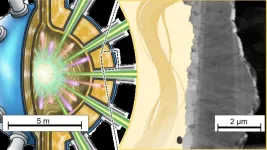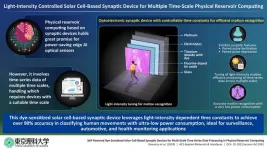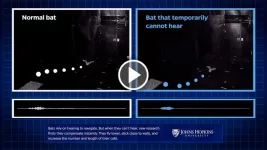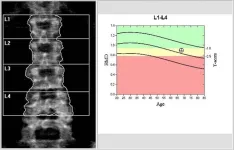(Press-News.org) ARLINGTON, Va., November 25, 2024 — The American Society for Radiation Oncology (ASTRO) issued today an updated clinical guideline for physicians who use radiation therapy to treat patients with locally advanced rectal cancer. This update incorporates new data on patient selection and best practices from several practice-changing clinical trials published since the prior guideline was issued in 2020. The updated ASTRO guideline is published in Practical Radiation Oncology.
Colorectal cancer is the leading cause of cancer deaths for Americans aged 20 to 49 and the second most common cause of cancer-related death overall. In the U.S., the incidence of early onset colorectal cancer is rising, with particularly sharp increases among younger adults. Rectal cancer diagnoses account for nearly one-third of colorectal cancers, and more than 46,000 adults in the U.S. are estimated to be diagnosed with this disease in 2024.
When ASTRO published its 2020 guideline for locally advanced rectal cancer, the standard of care included pre-operative chemoradiation therapy followed by surgery to remove the tumor and then post-operative chemotherapy. In the interim, several randomized trials explored intensifying treatment to potentially improve outcomes for patients at higher risk of cancer recurrence, and de-intensifying treatment to reduce side effects and potentially improve quality of life for patients with lower recurrence risk.
“This updated guideline incorporates new, practice-changing data that expand treatment options for people with rectal cancer. These include approaches such as non-surgical alternatives that enable organ preservation or the selective omission of radiation for patients with lower risk disease, total neoadjuvant therapy (TNT) courses for those with a higher likelihood of recurrence and newer biomarker-driven treatments such as immunotherapy,” said Prajnan Das, MD, MPH, FASTRO, chair of the guideline task force and a professor of gastrointestinal radiation oncology at The University of Texas MD Anderson Cancer Center.
“It is now clear that people diagnosed with locally advanced rectal cancer should be stratified into higher-risk and lower-risk groups. These emerging treatment paradigms allow for more personalized and nuanced recommendations that are tailored to each individual patient’s level of risk as well as their priorities, providing the right balance between effective cancer control and preserving quality of life,” said Jennifer Y. Wo, MD, vice chair of the guideline task force and an associate professor of radiation oncology at Harvard Medical School and Mass General Cancer Center.
The guideline outlines evidence-based approaches to personalize treatment for patients with locally advanced rectal cancer, with best practices for delivering pelvic radiation treatments, options for organ preservation and guidance for follow-up care. Key recommendations include the following:
Neoadjuvant radiation therapy is recommended for patients with stage II or III rectal cancer to reduce their risk of locoregional recurrence. A thorough clinical staging process — including a physical exam, pelvic MRI and evaluation by a multidisciplinary team — is essential to determine whether patients can be considered instead for upfront surgical resection or the selective omission of neoadjuvant radiation therapy. For patients at lower risk of locoregional recurrence, the guideline now conditionally recommends the selective omission of neoadjuvant radiation therapy; it also provides expanded criteria for defining lower risk disease. When radiation therapy is indicated, it should be given before, rather than after surgery.
Organ preservation through total neoadjuvant therapy (TNT) followed by non-operative management (NOM), or neoadjuvant chemoradiation followed by local excision, may present alternatives to radical surgery for select patients, with recent data supporting the safety and feasibility of NOM for patients who respond favorably to neoadjuvant therapy. The guideline outlines criteria for situations where surgery can be avoided, as well as best practices for long-term surveillance and care to support these patients.
Updated recommendations also describe regimens to treat patients at higher risk of recurrence who would likely benefit from an intensified treatment approach using TNT to improve outcomes.
About the Guideline
The update included a systematic literature review of articles published from April 2019 through October 2023. The multidisciplinary guideline task force included radiation, medical and surgical oncologists, a radiation oncology resident and a patient representative. The guideline was developed in collaboration with the American Society of Clinical Oncology and the Society of Surgical Oncology, and it is endorsed by the European Society for Radiotherapy and Oncology and the Royal Australian and New Zealand College of Radiologists.
ASTRO's clinical guidelines are intended as tools to promote appropriately individualized, shared decision-making between physicians and patients. None should be construed as strict or superseding the appropriately informed and considered judgments of individual physicians and patients.
Patient Resources
Videos: Radiation Therapy for Colon, Rectum and Anus Cancers; (Spanish); An Introduction to Radiation Therapy (Spanish)
Handouts: Radiation Therapy for Colon, Rectum and Anus Cancers; Side Effects of Colorectal Cancer Radiation Treatment
More patient information on radiation therapy: Radiation Therapy in Focus, RT Answers
ABOUT ASTRO
The American Society for Radiation Oncology (ASTRO) is the largest radiation oncology society in the world, with more than 10,000 members who are physicians, nurses, biologists, physicists, radiation therapists, dosimetrists and other health care professionals who specialize in treating patients with radiation therapies. Radiation therapy contributes to 40% of global cancer cures, and more than a million Americans receive radiation treatments for cancer each year. For information on radiation therapy, visit RTAnswers.org, featuring Radiation Therapy in Focus. To learn more about ASTRO, visit our website and media center and follow us on social media.
END
ASTRO issues update to clinical guideline on radiation therapy for rectal cancer
2024-11-25
ELSE PRESS RELEASES FROM THIS DATE:
Mount Sinai opens the Hamilton and Amabel James Center for Artificial Intelligence and Human Health to transform health care by spearheading the AI revolution
2024-11-25
See accompanying video here: https://youtu.be/o-opCV6oe3o
New York, NY [November 25, 2024]—Today, the Mount Sinai Health System, one of New York City’s largest academic medical systems, announced the opening of the Hamilton and Amabel James Center for Artificial Intelligence and Human Health, which is dedicated to enhancing health care delivery through the research, development, and application of innovative artificial intelligence (AI) tools and technologies.
The state-of-the-art research center solidifies ...
Researchers develop tools to examine neighborhood economic effects on spinal cord injury outcomes
2024-11-25
East Hanover, NJ – November 25, 2024 – Kessler Foundation researchers have developed robust measures of neighborhood economic factors to study how social determinants influence health outcomes after spinal cord injury (SCI). The study reveals that individuals in disadvantaged neighborhoods face higher risks of poor health, emphasizing the need for public policy to address environmental inequities.
Research scientists developed and validated two composite measures – neighborhood socioeconomic ...
Case Western Reserve University awarded $1.5 million to study vaginal bacterial linked to serious health risks
2024-11-25
CLEVELAND—Bacterial vaginosis (BV), the most prevalent condition affecting the female reproductive system in women aged 15 to 44, is linked to such serious health risks as preterm birth, gynecological malignancies and sexually transmitted diseases.
But effective long-term treatments for BV are limited: More than half experience a recurrence within six months, according to several studies.
With a $1.5 million grant from the National Institutes of Health (NIH), researchers at the Case Western Reserve School of Medicine will study the dynamics of BV in hopes of identifying a more effective approach.
“We hope to gain insights into promoting ...
The next evolution of AI begins with ours
2024-11-25
In a sense, each of us begins life ready for action. Many animals perform amazing feats soon after they’re born. Spiders spin webs. Whales swim. But where do these innate abilities come from? Obviously, the brain plays a key role as it contains the trillions of neural connections needed to control complex behaviors. However, the genome has space for only a small fraction of that information. This paradox has stumped scientists for decades. Now, Cold Spring Harbor Laboratory (CSHL) Professors Anthony Zador and Alexei Koulakov have devised a potential solution using artificial intelligence.
When Zador first encounters this problem, he puts a ...
Using sunlight to recycle black plastics
2024-11-25
Not all plastics are equal — some types and colors are easier to recycle than others. For instance, black foam and black coffee lids, which are often made of polystyrene, usually end up in landfills because color additives lead to ineffective sorting. Now, researchers report in ACS Central Science the ability to leverage one additive in black plastics, with the help of sunlight or white LEDs, to convert black and colored polystyrene waste into reusable starting materials.
“Simple, visible light irradiation holds the potential to ...
ODS FeCrAl alloys endure liquid metal flow at 600 °C resembling a fusion blanket environment
2024-11-25
Researchers explored protective coatings on advanced to resist corrosion in fusion reactors. They tested α-Al2O3 oxide layers on ODS alloys in a high-temperature, flowing lithium-lead environment. Even bare ODS alloys formed a durable γ-LiAlO2 layer in situ, which suppressed further corrosion. The layers exhibited strong adhesion under mechanical stress, making these findings crucial for improving material durability in fusion reactors and high-temperature energy systems.
Fusion reactors, a promising source of sustainable energy, require advanced materials that can withstand extreme temperatures and corrosive environments ...
A genetic key to understanding mitochondrial DNA depletion syndrome
2024-11-25
Mitochondrial DNA depletion syndrome (MTDPS) is a rare genetic disorder characterized by a marked decrease in mitochondrial DNA (mtDNA). This condition can cause symptoms including muscle weakness, fatigue, and neurological issues, particularly affecting the liver and brain in cases of hepatocerebral MTDPS. Mitochondrial diseases, which represent some of the most common types of metabolic disorders, can result in the failure of multiple organ systems. Currently, over 400 genes linked to these diseases have been identified. Notably, many of these genes are associated with the mitochondrial contact site and cristae ...
The future of edge AI: Dye-sensitized solar cell-based synaptic device
2024-11-25
Artificial intelligence (AI) is becoming increasingly useful for the prediction of emergency events such as heart attacks, natural disasters, and pipeline failures. This requires state-of-the-art technologies that can rapidly process data. In this regard, reservoir computing, specially designed for time-series data processing with low power consumption, is a promising option. It can be implemented in various frameworks, among which physical reservoir computing (PRC) is the most popular. PRC with optoelectronic artificial synapses (junction structures that permit a nerve cell to transmit an electrical or chemical signal to another cell) that mimic human ...
Bats’ amazing plan B for when they can’t hear
2024-11-25
When bats can’t hear, new research finds that these hearing-dependent animals employ a remarkable compensation strategy.
They adapt immediately and robustly, suggesting for the first time that bats’ brains are hard-wired with an ability to launch a Plan B in times of diminished hearing.
The Johns Hopkins University work, newly published in Current Biology, raises questions about whether other animals and even humans might be capable of such deft accommodations.
“Bats have this amazing flexible adaptive behavior that they can employ anytime,” said senior author ...
Common thyroid medicine linked to bone loss
2024-11-25
CHICAGO – Levothyroxine, the second most commonly prescribed medication among older adults in the U.S., may be associated with bone loss, according to a study being presented next week at the annual meeting of the Radiological Society of North America (RSNA).
Levothyroxine, marketed under multiple brand names including Synthroid, is a synthetic version of a hormone called thyroxine and is commonly prescribed to treat the condition hypothyroidism, or underactive thyroid. In people with hypothyroidism, the thyroid gland does not produce enough thyroxine on its own, often resulting in fatigue, weight gain, hair loss and other symptoms. If left untreated, hypothyroidism ...








